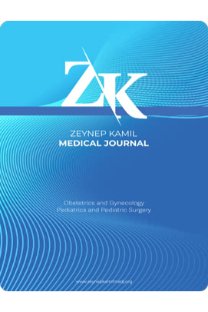Obstetrik hemorajide hipogastrik arter ligasyonu: tek cerrah deneyiminin kohort analizi
hipogastrik arter, internal iliak arter, hemoraji
Hypogastric artery ligation for obstetrical haemorrhage: cohort analysis of a single surgeon experience
hypogastric artery, internal iliac artery, haemorrhage,
___
- Referans1. World Health Organization (2009) Guidelines for Management of Postpartum Haemorrhage and Retained Placenta. WHO, Geneva, Switzerland.http://apps.who.int/rhl/archives/guideline_pphmanagement_kumars_com/en/index.htmlReferans2. Kaya B, Damarer Z, Daglar K, Unal O, Soliman A, Guralp O. Is there yet a role for internal iliac artery ligation in obstetric hemorrhage with the current gain in popularity of other uterus sparing techniques? J Matern Fetal Neonatal Med. 2017 Jun;30(11):1325-1332.Referans3. Camuzcuoglu H, Toy H, Vural M, Yildiz F, Aydin H. Internal iliac artery ligation for severe postpartum hemorrhage and severe hemorrhage after postpartum hysterectomy. J Obstet Gynaecol Res. 2010; 36(3): 538- 43.Referans4. von Elm E, Altman DG, Egger M, Pocock SJ, Gøtzsche PC, Vandenbroucke JP; STROBE Initiative. Strengthening the Reporting of Observational Studies in Epidemiology (STROBE) statement: guidelines for reporting observational studies, BMJ 2007;335:806–8. Referans5. Countdown to 2015: Maternal, Newborn and Child Survival [Internet]. WHO and UNICEF, 2012. Available at: http://www.countdown2015mnch.org/documents/2012Report/2012- Complete.pdf. Referans6. Miller S, Lester F, Hensleigh P. Central European University. Prevention and Treatment of Postpartum Hemorrhage: New Advances for Low-Resource Settings. The Journal of Midwifery & Women’s Health, 2004, 49(4):283–92. Referans7. Burchell RC: Internal iliac artery ligation: Hemodynamics. Obstet Gynecol 1964 ;24: 737-9.Referans8. Sentilhes L, Vayssiere C, Deneux-Tharaux C, Aya A, Bayoumeu F, Bonnet M, et al. Postpartum hemorrhage: guidelines for clinical practice from the French College of Gynaecologists and Obstetricians (CNGOF) in collaboration with the French Society of Anesthesiology and Intensive Care (SFAR). European Journal of Obstetrics & Gynecology and Reproductive Biology 2016;198:12-21.Referans9. Joshi V, Otiv S, Majumder R, Nikam Y, Shrivastava M. Internal iliac artery ligation for arresting postpartum haemorrhage.BJOG 2007;114:356–361.
- ISSN: 1300-7971
- Yayın Aralığı: 4
- Başlangıç: 1969
- Yayıncı: Ali Cangül
Dilara Fatma AKIN BALI, DENİZ AŞLAR ÖNER, Nejat AKAR, A. Emin KÜREKÇİ
Şebnem EROL TÜRKYILMAZ, Gürcan TÜRKYILMAZ, Murat APİ
Atopik dermatitte biyo belirteç olarak eozinofil ve IgE.
Atopik Dermatitte Biyo Belirteç Olarak Eozinofil ve IgE
Jinekolojik Kanserler ve Pelvik Egzenterasyon Kısa Dönem Sonuçları Tek Merkez Deneyimleri
HAMDULLAH SÖZEN, Özgür TOSUN, Engin ÇELİK, Yağmur MİNARECİ, İbrahim YALÇIN, D VATANSEVER, Samet TOPUZ, Yavuz SALİHOĞLU
HAMDULLAH SÖZEN, Merve BAKTIROGLU, Harika YUMLU, İrem USTA, İbrahim YALÇIN, KAMURAN İBİŞ, Seden KÜÇÜCÜK, Samet TOPUZ, Yavuz SALİHOĞLU
Hamdullah Sözen, Merve BAKTIROGLU, Harika YUMRU, İrem USTA, İbrahim YALÇIN, Seden KUCUCUK, Kamuran IBIS, Samet TOPUZ, Yavuz SALİHOGLU
MULTİPLE SKLEROZLU VE EROİN KULLANIM BOZUKLUĞU OLAN KADINLARIN CİNSEL İŞLEV DÜZEYİ
Kemal SANDAL, Mesut POLAT, Murat YASSA, Taner GÜNAY, Gamze YETİM ERDEM, Kadir GÜZİN
Makrozomik Fetuslarda Doğum Şekli Oluşabilecek Komplikasyonları Önler mi?
Sezin ERTÜRK AKSAKAL, Şafak ÖZDEMİRCİ, Füsun BOCUTOĞLU, Baran YEŞİL, Leyla MOLLAMAHMUTOĞLU, Ömer LÜTFİ TAPISIZ
